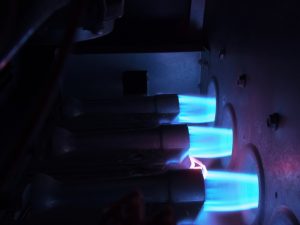 Furnaces of the past had a lot of issues in terms of home safety. Unfortunately, it was once all-too-common for a fire to break out due to a furnace malfunction, or a carbon monoxide leak to make people ill. Today, as you might expect, modern engineering has led to a much safer furnace.
Furnaces of the past had a lot of issues in terms of home safety. Unfortunately, it was once all-too-common for a fire to break out due to a furnace malfunction, or a carbon monoxide leak to make people ill. Today, as you might expect, modern engineering has led to a much safer furnace.
Remember that anytime natural gas is used in an ignition system, there is a risk associated. However, modern safety switches within furnaces make it far less likely that something like an explosion or leak could occur. Combine this with routine professional inspections of your heater, and you can feel at ease. Read on to learn more about the switches inside your gas furnace that keep you safe and protect the system.
Flame Sensor/Thermocouple
A flame sensor is useful in preventing gas leaks and excessive gas buildup that could lead to fires. If no flame is detected at the burners after a certain amount of time, the flame sensor detects this and shuts off the furnace.
In an older furnace—one that has a standing pilot that’s on at all times rather than using electronic ignition—this is called a thermocouple. This simply sends a signal to the control board of the furnace if there is no flame at the pilot light, to shut the system off.
Limit Switch
The limit switch ensures the furnace plenum never gets heated to a higher temperature than is safe. It is often called the fan limit switch because it can work together with the component that ensures the fan does not turn on until the plenum has had a chance to heat up in the first place. If the fan is not working properly, heat will not vent correctly into the home, and the plenum may heat up to dangerous levels—if not for this limit switch.
Air Pressure Switch
This is not a component of all furnaces. However, most modern high-efficiency units have a vent fan that helps ensure byproducts of the combustion process—including dangerous ones like carbon monoxide—get exhausted to the outside of the home. The air pressure switch is able to detect whether or not enough air pressure is moving safely out of the furnace flue. Otherwise, it’s possible for carbon monoxide to leak into your home.
Other Factors to Furnace Safety
You cannot rely on the furnace safety switches to protect your home indefinitely. No component can last forever! Besides, there are further steps to keeping your home safe than simply purchasing a well-manufactured system.
- Proper Installation – Your furnace must be the right size for your home and installed securely by an HVAC expert. This is never a job for an amateur!
- Routine Maintenance/Inspections – Routing maintenance of your system helps to ensure the safety switched remain in good working condition. Moreover, technicians will check for cracked heat exchangers along with other risk factors of carbon monoxide leaking and fires. Schedule maintenance for your heater once a year, as early in the season as possible.
- Prompt Repairs – Finally, a key component of furnace safety is recognizing problems within your system and scheduling repairs as soon as possible so that they cannot get any worse and put your home at risk.
Schedule your next furnace repair in Falcon, CO or a routine safety inspection with Robbins Heating & Air Conditioning today.
